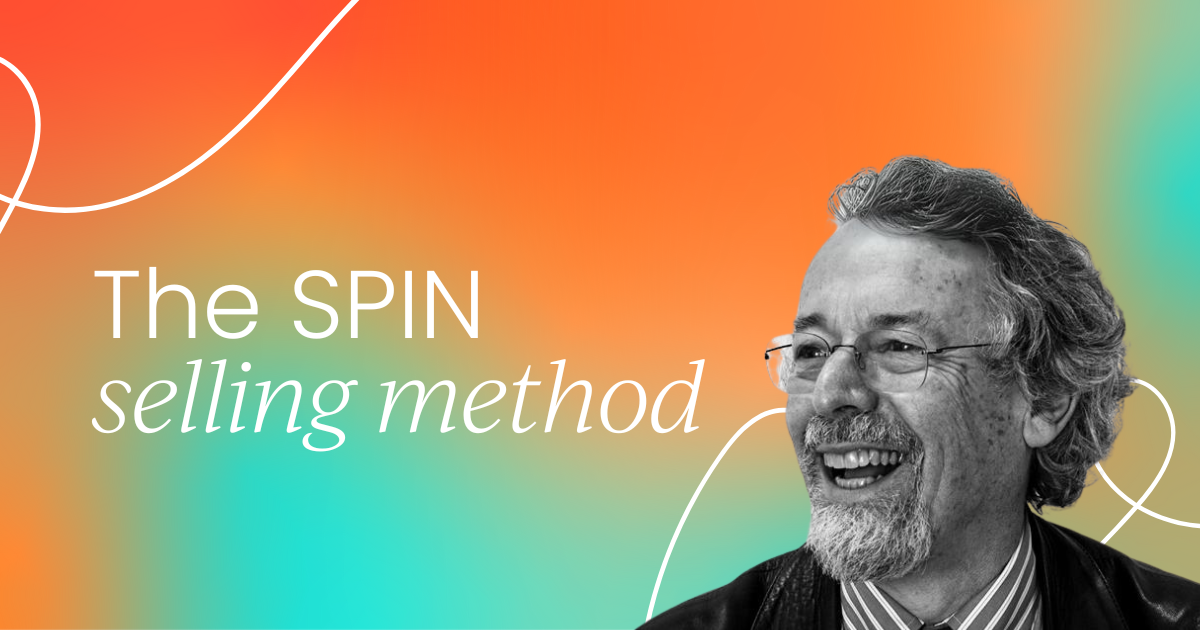As part of our series on sales methodology, we’re looking at one of the oldest around: the Sandler sales methodology, also known as the Sandler selling system.
David Sandler devised this methodology in 1967 to encourage sales professionals to take a consultative approach to the sales process.
Sandler sales training has been helping reps reach quota ever since.
Much like the MEDDIC sales methodology, the Sandler selling system aims to make qualifying a lead as structured and straightforward as possible for a salesperson.
The Sandler sales methodology
The Sandler sales methodology puts particular emphasis on qualifying leads and acting as their consultant. The ultimate goal of the Sandler sales method is to become a trusted advisor to customers who truly need and will benefit from your solution.
At the same time, you’ll be looking to actively disqualify leads who are not a good fit. That means undergoing a serious qualification process during the discovery phase. You need to understand the lead’s situation and circumstances before you can make a judgment like this.
In 5 Key Shifts: Your workbook to drive sales team performance, Jeff Jaworski from The Shift makes the following statement regarding effective meetings with prospects:

 Jeff Jaworski
Founder, Sales Enablement Leader, The Shift Consulting
“It all must be anchored in what they need and how you can address those needs”.
Jeff Jaworski
Founder, Sales Enablement Leader, The Shift Consulting
“It all must be anchored in what they need and how you can address those needs”.
Bearing in mind the importance of qualifying leads as part of the Sandler sales methodology, let’s have a quick refresher on lead qualification. 👇
Why does lead qualification matter?
In sales, potential customers are called leads.
- A qualified, “good” lead is one worth pursuing right now…
- While an unqualified, “bad” lead isn’t worth your time (yet).
Sales teams can only speak to a certain number of prospective customers in a day. It’s crucial they spend their time on the phone with qualified leads, because they have the best chances of converting into paying customers.
If salespeople are spending too much time on sales calls with leads who are unlikely to buy, they’re wasting precious time.
But is this a real problem? The data suggests so. Our most recent Sales Enablement Landscape Report indicates that 32% of sales teams face the challenge of “Not enough qualified leads/wasting time on unqualified leads.

This is why lead qualification, and methodologies like Sandler which emphasize it, are so important. It’s about understanding the person you’re talking to, and the company they work for. What are their needs? What’s their situation? Is your product even a good fit for the problems they’re facing?
That’s where methodologies like the Sandler sales process come in. They give sales reps a structured approach to the sales cycle they can follow every time.
The Sandler submarine
The Sandler selling method consists of seven steps. David Sandler used a submarine analogy to explain these steps.
When a submarine floods, the crew moves from one compartment to another, closing each door behind them. They can’t go back and open a previous compartment’s door, otherwise the flooding will spread.
Sandler saw his sales system as working similarly. You move from one stage of the sales process to the next. But before you can progress, you have to ‘secure’ the stage you’re at.
If you don’t, you risk ‘sinking’ the sale, just as a crew risks sinking a submarine.

The 7 stages of the Sandler selling system
1 - Bonding and rapport
Remember, you’re building a relationship with the prospect. Encourage open, honest communication, and try to present yourself as an impartial advisor, more than a sales rep with an agenda.
Establish a human connection and be personable from the get-go.
5 Example questions for this stage:
- “How did you get started in your industry?”
- “What do you enjoy most about your role?”
- “What are some of the biggest challenges your company is facing right now?”
- “How has your business changed over the past few years?”
- “When working with vendors like us, what qualities do you value most?”
2 - Up-front contract
This step involves establishing roles and setting expectations between you and the prospect.
Using that open, honest communication you’ve established, you’ll make sure the prospect knows exactly what’ll happen during the meeting. That includes what will be discussed, and how long it will take.
This helps to avoid situations where you and the prospect are prepared for different things heading into the conversation. It puts you and the prospect on the same page and helps build on the mutual trust you’ve already started to create.
5 Example questions for this stage:
- “Would it be okay if we took the next 30 minutes to discuss your challenges and see if we’re a good fit?”
- “At the end of our conversation, would you be comfortable telling me if this isn’t the right fit for you?”
- “What would a successful meeting look like for you today?”
- “If we determine that we can help, what would be the next steps from your side?”
- “Are there any key decision-makers who should be part of this discussion?”
3 - Pain
Once the relationship has been established, it becomes time to uncover and identify the prospect’s pain points.
This is when you start qualifying your lead. You’re discovering their frustrations, difficulties, and problems. The ones they face every day. It’s here that you’ll begin to understand how your product or service can help your prospect.
Go beyond the obvious. The deeper questions reveal a lot more about your lead’s organization and whether your product is a fit for them.
Deeper questions include:
- “How long has this been a problem?”
- “How have you tried to solve this problem and failed?”
- “What’s the one thing you’re doing right now that is helping more than anything else?”
Sandler’s pain funnel is a key component of this methodology and helps sales reps dive deeper into a lead’s pain by guiding them on the types of questions they ask.
5 Example questions for this stage:
- “What’s the biggest frustration you’re currently dealing with in your business?”
- “How is this issue impacting your daily operations or overall business goals?”
- “What have you tried in the past to solve this problem? How did that work out?”
- “If you don’t address this challenge, what will happen in the next 6-12 months?”
- “How does this issue affect you personally?”
4 - Budget
Next up is budget. This is where you discover whether the lead’s organization can actually afford the solution you’re selling.
You might be able to solve every problem the prospect is facing, but if your solution costs double their budget, there’s no point in pressing and trying to sell it to them.
Rather than do all the hard work of discovery and asking about budget at the end, the Sandler sales model has you ask about the lead’s budget relatively early on.
This saves you the heartache of putting in lots of work, only to discover they can’t afford your offer.
Additionally, here you’ll be able to find out if the lead’s organization is prepared to invest not just money, but time and other resources into solving the pain points they’re facing.
5 Example questions for this stage:
- “Have you allocated a budget for solving this problem?”
- “What kind of investment have you made in the past for similar solutions?”
- “If we find the right solution for you, how do you typically justify the cost internally?”
- “What financial impact is this problem currently having on your business?”
- “Are there any financial constraints that would prevent us from moving forward?”
5 - Decision-making process
In this step, you’ll find out who the decision-makers are, and what the prospect’s buying process looks like.
Here’s a quick list of things to consider at this point in the sales strategy:
- Who makes the decisions regarding purchases?
- How many people are involved?
- How long does the decision-making process take?
- How does the prospect expect the process to go?
If you cover these bases, you can anticipate any possible complications.
You’ll also discover whether you’re in communication with all the people you need involved if you’re going to close the deal.
5 Example questions for this stage:
- “Can you walk me through how your company makes decisions on purchases like this?”
- “Who else, besides yourself, needs to be involved in the decision?”
- “What criteria will you use to determine the best solution for your needs?”
- “Have you made similar purchasing decisions in the past? If so, what worked well and what didn’t?”
- “If we agree on a solution today, what would the approval process look like on your end?”
6 - Fulfillment
Now we move towards the tail end of the process, with the fulfillment stage. It’s easy to get excited because you can almost smell the deal about to close, but you need to stay focused and remember the submarine analogy.
In this stage, you propose your solution to the lead’s problem, and highlight that it’s within budget and consistent with the decision-making process that you discerned earlier.
Tailoring your exact approach might be necessary here, in order to meet the prospect’s specific needs.
Use everything you’ve learned in the previous stages to make the proposal as appealing as possible (while remembering your role is that of a trusted advisor).
To state it simply, this stage is about giving the lead a solution to their problem that’s compliant with their budgetary constraints, and the demands of their decision-making process.
5 Example questions for this stage:
- “Based on what we’ve discussed, does this solution address your key concerns?”
- “How do you see this solution fitting into your current operations?”
- “Are there any specific concerns or objections you’d like to address before moving forward?”
- “What would a successful implementation look like for you?”
- “If we move forward with this, what would your timeline look like?”
7 - Post-sell
If you’ve made it this far, then you’ve sealed the deal - well done! But it’s not over yet.
In the post-sell stage, you discuss the next steps between you and the prospect’s organization and how your new partnership will develop.
You should consider how the onboarding process will go, what training programs can be provided, whether there are any cross-sell opportunities, how you’ll follow up with the prospect, and more.
These steps ensure a smooth transition for the prospect and help prevent buyer’s remorse.
The last thing you want is to seal a deal, but have your new customer confused, not utilizing the product or service properly, and leaving for one of your competitors.
5 Example questions for this stage:
- “Now that we've agreed on the solution, what’s your biggest concern moving forward?”
- “What steps can we take to ensure a smooth implementation?”
- “Who on your team should we coordinate with to get everything up and running?”
- “What expectations do you have from us in terms of ongoing support?”
- “Can I check in with you in a few weeks to ensure everything is going as planned?”
Sandler in summary
The Sandler pain funnel (with example questions)
But what about the pain funnel we mentioned earlier?
The Sandler pain funnel is all about asking deeper questions.
Why? High-ticket sales require bespoke deals and hyper-personalization. Sales reps need to tailor their approach to the prospect in front of them.
In our AI and Sales eBook, Ronan Kirby, CCO at Starmind notes that “People want hyper-personalized experiences — personalized is what converts. But it’s still a numbers game... You’re trying to juice your conversion rate, and hyper-personalization dramatically impacts that”.
This supports the idea of going beyond surface-level understanding, which the Sandler pain funnel helps you with. And hints at the role AI can play in taking the personalization involved in Sandler’s methodology a step further.
This is a key component of the Sandler methodology, and is designed to help sales reps during the pain stage of the process.
The pain funnel helps reps go beyond surface-level questions, and guides them down a path of second- and third-level questions that provide much more valuable information.
Once your surface-level question has revealed a possible pain point, use the pain funnel to direct your questioning.
Here’s the pain funnel sequence — the further down you go, the more you discover:
- “Tell me more about that?”
- “Can you be a little more specific?”
- “How long has that been an issue?”
- “What have you tried to do to solve it?”
- “Did that work?”
- “How much do you think that has cost you?”
- “How do you feel about that?”
- “Have you given up on solving the issue?”
As you can see, these types of questions will undoubtedly give you more insight into the prospect’s situation.
Use the funnel as a template, because you’ll need to tailor your line of questioning depending on the circumstances - but you can always follow the pain funnel sequence.
Benefits of the Sandler sales methodology
Now we know what the Sandler method is… Why should you use it?
- It eliminates low probability prospects early on, meaning sellers waste less time trying to close leads who’d never buy.
- It gives the buyer a chance to tell the sales rep exactly how they can be sold.
- Reduces negative experiences for sellers. They don’t have to chase buyers who aren’t interested, meaning they succeed more often, boosting their morale and their motivation to sell more.
- Uncovers possible objections early, allowing the seller to handle them before they ask for the close.
- Expectation-setting also gives buyers less room to negotiate on price towards the end of the sale, meaning higher profit margins.
- The slower, methodical approach is well-suited to B2B sales cycles, which are longer, more complex, and involve multiple decision-makers and high-ticket items.
What we’ve learned
To recap, the seven stages of the Sandler sales methodology involve qualifying your leads and identifying those who are a good fit for your product or service.
You act in a consultative, advisory fashion, guiding the prospect towards your solution.
Guiding your prospect is done by following the seven ‘Sandler submarine’ stages, as follows:
- Establish bonding and rapport, with open and honest communication
- Create an up-front contract and set expectations with your prospect
- Identify the prospect’s pain points and learn how you can help
- Discover the prospect’s budget and whether they can afford your solution
- Learn about the decision-making process in the prospect’s organization
- Propose a solution to the prospect’s problems that meets their requirements
- Establish next steps and how you’ll support the new customer post-sell
If you’re researching sales methodologies, take a look at our guides to the Miller Heiman and MEDDIC methodologies too.
Looking for next steps?
10,000+ sales enablers from all over the world trust SEC to be the go-to resource for their learning and development. Benefit from our community-led resources through the insider plan, for free!
- Templates and frameworks: Save time with battle-tested and ready-to-use templates. 📖
- SEC-GPT: Solve challenges with the cumulative knowledge of our community. 🤖
- Real-world case studies: Hours of insights from leaders at Uber, Oracle, Adobe, and more. 🗣️
- Industry insights: Ungated access to first-hand research from thousands of sales enablers in our annual Salary and Landscape Report. 📈
- Supportive community: Join our global community of sales enablers whom you can bounce ideas around with and get support from other like-minded professionals. 🤝
Accelerate your career without spending a dime.
Become an SEC insider now. 👇



Sales enablement insider
Thank you for subscribing
Level up your sales enablement career & network with sales enablement experts
An email has been successfully sent to confirm your subscription.
 Follow us on LinkedIn
Follow us on LinkedIn


.png)







